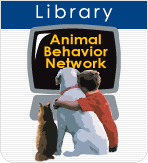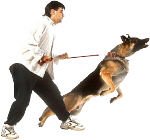|
Need Help? |
|
Call
1-800-372-3706
to
speak to a Veterinary Behavior Technician |
|
Paws for Help!
|
|

Click on Library Icon |
|
Help is at your
fingertips
by
library, email
and phone! |


|
|
Dog Behavior Library
|
Methods for
restraining fearful
and aggressive
dogs
Lowering fearful
aggression
When the dog
is in the hospital, be sure
staff carries
treats or cheerios to toss
through the
kennel or run door EVERY
time they pass. Be
sure the staff understands
canine body language and
communicates no threat to the
dog using their human body
language
The goal is
use body
language and food peace
offerings to help
the dog
understand
that everyone who comes
by is a friendly cookie giver
and NOT a threat.
(If the dog has a veterinary
phobia due to a past painful or
stressful visit, medications may
be indicated to give the dog
comfort.)
Chances are
that while the staff may not
feel safe around
an aggressive
dog, the dog may not feel safe
and believe the staff are
going to harm her. So if she
can be lured
into wearing
the leash that would
help.
For staff
safety, you
can use large pieces of
stiff cardboard
as a
block to an
unexpected bite or to reduce the
kennel area.
The goal is to
change the dog's perception of
contact as a good thing by
offering treats and a chance to
eliminate. Rotate the dog to a
clean area using food so that
you can clean an empty kennel.
Why Restrain Dogs?
The definition of
restraint is "holding a pet still
thereby taking away his or her
freedom" for a moment. The purpose
of being able to safely restrain pet
is to allow grooming, an exam or
other procedure to be
completed safely.
The most important
criteria is safety for the pet,
family, handler and pet
professional. It is most helpful for
the dog to learn as a puppy that any
family member or friendly human can
hold the dog still at any time, and
the dog simply relaxes and goes with
the program.
The goal is to have every pet enjoy
gentle handling and
to be able to distract him or her from
possible pain with food
treats, noises, blowing on or tapping
the nose or spinning or pushing
it along the table to divert attention.
If the pet is struggling excessively
in the veterinary setting,
it may be preferable to use Chemical
Restraint (using tranquilization
to reduce the need for forceful
handling).
Restraining
Aggressive Dogs
Aggressive dogs,
regardless of motivation, are the most likely
to bite. Only experienced handlers
should handle them. Bite wounds
result from an inexperienced
handler who was too shy (or too
overconfident) to call for help.
Don't take risks, call for
help if you have any doubt.
A difficult problem is getting an
aggressive pet out of a kennel. Ideas
for experienced handlers: Try to
leave their leash on the pet, and
tie it directly to the outside of
the kennel If the leash is not attached
and you need to get the pet out
of a kennel, use a coat hanger to
loop a leash over the head, or use
a large towel over the head of small
dogs. If in doubt, call an experienced animal handler.
The best way to learn to read dog
body language is by observing an
experienced handler. Chemical Restraint
(tranquilization) may prevent a
bad veterinary experience that would have made
the dog even more difficult in the
future. While the animal is sedated,
you still need to handle gently to build trust.
Aggressive Dog Postures
All aggressive dogs have one body
language characteristic in common:
the "frozen" or "statue"
posture. When a dog freezes, it
may attack without any other sign,
so watch for the tell-tale frozen
posture, then back off and call
for help.
With aggressive dogs (that may bite
you), there are really two categories:
Control Based and Fearful.
Control
Based Aggression
This usually occurs in guard type
dogs who are not properly restrained
and taught manners as puppies. The
typical posture for the
aggressive dog is to try to make
itself look as BIG as possible to
intimidate its enemy. Therefore,
these dogs will stand still or MOVE
FORWARD. Other signs are ears UP
and forward,
tail UP, stance ERECT, and hair
raised on their backs. They may
give warnings like growls, showing
teeth or barking. These pets bite
to show that they are your boss.
Aggressive
Dogs Who Have Bitten
A good general rule of thumb is
this: if the family cannot muzzle
their own dog, and if it is an
elective visit, you should refuse to
handle the dog until after they have had a session
with a professional behaviorist
who can teach them how to muzzle their
own dog. Once the dog is muzzled,
in the veterinary setting, consider chemical restraint.
Once the
dog is tranquilized, people can firmly
but gently handle the dog. The goal should be
to build trust so that the pet can be safely handled
in the future. Recommend intact males
be neutered to reduce aggressiveness.
Dogs Who
Have Never Bitten
A relatively new option, is to fit
these dogs with a Gentle Leader
head halter. Even if they have never
worn one before, it can be used
as a restraint device. Pull the
head up if the dog is misbehaving,
and relax the pressure as the dog
relaxes. The reward to the dog for
good behavior, is less pressure.
As a last resort, sometimes heavy
physical restraint (multiple people)
works when the dog is
controlling but
not aggressive. When he feels there
is no benefit in struggling, he
will stop. If there is any indication
it is becoming aggressive, stop
and muzzle. If impossible to muzzle,
and there's no other alternative,
use a loop pole or pull the leash
through a door jamb, and allow Dr.
to administer tranquilization. If
the owner can't or won't
allow muzzle or chemical restraint,
decline service and refer to a behaviorist,
but do not risk injury.
Fearful Aggressive
Dog Postures
Fear aggressiveness occurs in dogs
who are genetically fearful or poorly
socialized as puppies, or both.
They are often inexperienced or
had bad early experiences. They
see handlers as feared enemies.
The body posture is intended to
make the pet look as SMALL as possible,
such as backing into a corner. Other
signs are tail DOWN, ears DOWN or
back. These dogs may give warnings
like growls, showing teeth or barking.
Or they may not give any warning
(except frozen posture) before biting.
These pets bite in imagined self-defense
because they think you are going
to kill them.
Restraint
Techniques for Fearful Dogs
First, try building their confidence.
Get low, either crouching or on
your knees. Face away from the dog,
and offer your hand for sniffing.
Talk in a high, happy voice. Ask
the owner to give you the leash,
then move behind you. If the owner
is behind you, the dog cannot think
he is protecting the owner. If the
owner was the dog's source
of confidence, it is now apparent
the owner is on your side. Hold
the leash about 1 foot from the
collar, and pull it up to pull the
dog's teeth up and away, then
slip the other hand under his middle
and lift him onto the table. Immediately
try to reassure him while the owner
stays back. Ideally, the dog will
see you as trustworthy. When you
have to give an injection, be sure
to distract the dog with a cookie,
or have your assistant hug the dog
firmly.
This personality is similar to fearful
aggressive, except these dogs have
a high reluctance to bite (high
bite threshold). The key body language
difference is that these pets often
quiver a tucked tail, roll over
to show their belly, or urinate.
These are all signs of submission.
Go slowly since these dogs can have
their confidence built slowly. Do
muzzle them to give injections,
because they can turn aggressive.
If they can tolerate it, massage
their body to build their trust.
One way to see if confidence is
being built is to offer a tasty
food treat (e.g., piece of doggy
beef jerky or lump of canned dog
food). How readily the dog will
accept food is a measure of trust
and confidence.
Friendly
Non-Aggressive
These
are the delightful dogs we handle
most of the time. The key body
language gestures are tail wagging
and fluid motion (no "frozen
posture"). In most cases they will
approach you in a relaxed posture,
often lick your hand and ask to be
petted.
Restraining Non-Aggressive Dogs
This category of dogs
can also be divided into two sub-categories:
fearful and friendly.
Fearful Non-Aggressive
This personality is similar to fearful
aggressive, except these dogs have a
high reluctance to bite (high bite threshold).
The key body language difference is
that these pets often quiver a tucked
tail, roll over to show their belly,
or urinate. These are all signs of submission.
Go slowly since these dogs can have
their confidence built slowly. Do muzzle
them to give injections, because they
can turn aggressive. If they can tolerate
it, massage their body to build their
trust.
One way to see if confidence is being
built is to offer a tasty food treat
(e.g., piece of doggy beef jerky or
lump of canned dog food). How readily
the dog will accept food is a measure
of trust and confidence.
Friendly Non-Aggressive
These are the delightful dogs we handle
most of the time. The key body language
gestures are tail wagging and fluid
motion (no "frozen posture").
In most cases they will approach you
in a relaxed posture, often lick your
hand and ask to be petted.
|
The Golden Rule of Restraint
Do Unto The Pet The
Way You Would Want Others To Do
Unto Yours! |
|
|
|